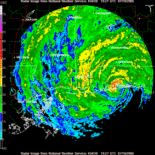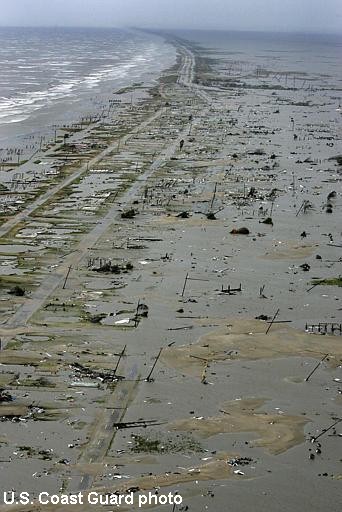dhweather wrote:wxman57 wrote:dhweather wrote:Also, this goes back to the argument that the NHC needs to have a seperate SURGE WARNING for hurricanes.
A storm coming down from a 5 to a 2/3 will still have the surge of a 4/5 at landfall in the GOM.
A storm coming up to a 2 from a TS or 1 will have the surge of a TS or 1, with small areas of 2 surge.
I disagree with the logic above. As per my previous post, storm surge is more a function of the areal coverage of a hurricane's higher wind speeds (74+ mph, for example) than a function of the peak wind that may cover only a limited number of square miles (based on SS scale). Here's an example.
Let's say we have a hurricane with hurricane-force winds extending out 100 miles in all quadrants. That's an areal coverage of 31, 400 square miles. Now let's assume it's a Cat 4 with 140 mph winds only in the NE Quadrant at a distance of about 20 miles from the center. That's a max areal coverage of Cat 4 winds of probably 200 square miles at the most (that may be generous). Now, drop the wind speed in that 200 sq. mile area from 140 to 120 mph and you're not going to significantly affect the storm surge that extends out to 100 miles or more from the center. Such a reduction of ONLY the peak wind speed (all else being equal) may have an insignificant effect on the storm surge of a landfalling hurricane.
That's basically what happened last season with Katrina and Rita. The 74+ mph wind field remained constant but the small area of peak winds northeast of the core weakened a few categories. Therefore, Katrina and Rita produced a storm surge that was greater than what the SS scale would indicate for an average-sized Category 2 or 3 hurricane.
But you can't say that Rita or Katrina produced a Cat 4 or Cat 5 surge, as there's no such thing. Katrina was a Cat 3, so it produced a surge reprensentative of what a much larger-than-average Category 3 hurricane would normally produce. It's just that the SS scale doesn't consider such abnormalities.
So, in the same line of thinking, you can't arbitrarily state that a Cat 2 which weakens to a strong TS at landfall would produce a "Cat 1 surge" or that a Cat 5 that weakens to a Cat 2/3 will have a "Cat 4/5 surge". That's simply not true under all circumstances. It MAY be true that if only the peak wind is reduced (not the areal coverage of 74+ mph winds) then a Cat 5 that weakens to a Cat 2/3 at landfall would produce a storm surge that would be much larger than that expected from a typical Cat 2/3.
On the other hand, if Katrina had not only weakened from a Cat 5 to a Cat 3, but had its hurricane-force and greater wind field areal coverage decreased by half or more, then Katrina would not have produced a storm surge nearly as extensive as it did. A further reduction of the area of Katrina's higher wind radii prior to landfall may have resulted in a storm surge more typically associated with a landfalling Category 3 hurricane.
I still have to look at what history tells me:
Here's a list of storms that were cat 5's in the Gulf of Mexico, and their surge at landfall:
2005: Rita "At least 15 feet" (Cameron Parish, LA)
2005: Katrina 30+ Feet (Bay St. Louis, MS)
2004: Ivan 12 feet (Navarre Beach, FL)
1969: Camille 27 Feet (Bay St. Louis, MS)
1967: Beulah "At least 18 feet" (30MI S Corpus Christi)
1961: Carla 18.5 feet (Port Lavaca, TX)
In the last 45 years, hurricanes that have been category 5 strength
in the Gulf of Mexico, all but Ivan produced category 5 surge.
There are many things that contribute to the storm surge, however, I
believe that once a hurricane reaches category 5 strength in the
GOM, the overwhelming odds are that it will produce category 5
storm surge at landfall, regardless of its SS intensity.
The SS scale has a category 5 hurricane storm surge listed as:
Storm surge generally greater than 18 ft above normal.
according to local reports Mackey Cove in upper Escambia Bay had a measured surge of 18 feet. There were also local reports in several places of surge greater than 12 feet.
docjoe







